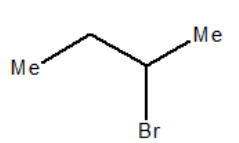Question
Question: Compound \[\left( {\operatorname{Sec} - {\text{Butyl}} - {\text{bromide}}} \right)\] undergoes alkal...
Compound (Sec−Butyl−bromide) undergoes alkaline hydrolysis by:

A.SN1
B.SN2
C.Both A and B
D.None
Solution
SN1 involves formation of carbocation and the species which can form stable carbocation are more likely to SN1 mechanism. In the case of SN2 mechanism, species with least steric hindrance are more likely to follow SN2 path.
Complete step-by-step answer: In case of SN1 , it is a nucleophilic substitution unimolecular reaction. It is a two step reaction, first step involves formation of carbocation and it is the rate determining step and in second step nucleophile attacks on carbocation intermediate. Characteristics of SN1 reactions are unimolecular which means its rate determining step, formation of carbocation is of first order reaction. The species which forms stable carbocation in the first step is more likely to show SN1 mechanism. Rearrangement of carbocation can take place but this will not affect the rate. In this mechanism, polar protic solvent like water, acetic acid, methanol, and ethanol are used. This mechanism is exothermic and prefers to be performed at low temperature.
In case of SN2 , it is a nucleophilic substitution bimolecular reaction. It is a one step reaction which involves attack of nucleophile on substrate; this step is of second order reaction and is a rate determining step. The steric hindrance affects the rate of this reaction by making difficulty in attack of nucleophile on the species. There is no formation of carbocation and transition state cannot be isolated from the reaction. The nucleophile donate its electrons in an anti bonding orbital of carbon. The solvent used is polar aprotic like DMSO and DMG. The reaction is exothermic and prefers to perform at low temperature.
As in case of given reactant (Sec−Butyl−bromide) , due to the steric hindrance by methyl and ethyl group of carbon, it is more likely to follow SN1 mechanism as due to steric hindrance b these group, it will cause difficulty in attack of nucleophile on carbon and also it is a secondary halide which can forms a stable carbocation intermediate which is favorable for SN1 mechanism.
Thus, the correct option is A.
Note: In SN1 mechanism, the nucleophile can attack on both the sides namely front and back. So the product formed is a mixture of both the stereoisomers, also known as a racemic mixture. But in case of SN2 , only backside attack, Walden inversion.

